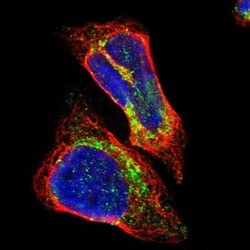Antibody data
- Antibody Data
- Antigen structure
- References [3]
- Comments [0]
- Validations
- Immunocytochemistry [1]
Submit
Validation data
Reference
Comment
Report error
- Product number
- HPA012604 - Provider product page

- Provider
- Atlas Antibodies
- Proper citation
- Atlas Antibodies Cat#HPA012604, RRID:AB_1844721
- Product name
- Anti-ALDH18A1
- Antibody type
- Polyclonal
- Description
- Polyclonal Antibody against Human ALDH18A1, Gene description: aldehyde dehydrogenase 18 family, member A1, Alternative Gene Names: GSAS, P5CS, PYCS, Validated applications: ICC, IHC, WB, Uniprot ID: P54886, Storage: Store at +4°C for short term storage. Long time storage is recommended at -20°C.
- Reactivity
- Human, Mouse, Rat
- Host
- Rabbit
- Conjugate
- Unconjugated
- Isotype
- IgG
- Vial size
- 100 µl
- Concentration
- 0.1 mg/ml
- Storage
- Store at +4°C for short term storage. Long time storage is recommended at -20°C.
- Handling
- The antibody solution should be gently mixed before use.
Submitted references A proline metabolism selection system and its application to the engineering of lipid biosynthesis in Chinese hamster ovary cells
Pyrroline-5-carboxylate synthase senses cellular stress and modulates metabolism by regulating mitochondrial respiration
MYC regulation of glutamine–proline regulatory axis is key in luminal B breast cancer
Budge J, Roobol J, Singh G, Mozzanino T, Knight T, Povey J, Dean A, Turner S, Jaques C, Young R, Racher A, Smales C
Metabolic Engineering Communications 2021;13
Metabolic Engineering Communications 2021;13
Pyrroline-5-carboxylate synthase senses cellular stress and modulates metabolism by regulating mitochondrial respiration
Yang Z, Zhao X, Shang W, Liu Y, Ji J, Liu J, Tong C
Cell Death & Differentiation 2020;28(1):303-319
Cell Death & Differentiation 2020;28(1):303-319
MYC regulation of glutamine–proline regulatory axis is key in luminal B breast cancer
Craze M, Cheung H, Jewa N, Coimbra N, Soria D, El-Ansari R, Aleskandarany M, Wai Cheng K, Diez-Rodriguez M, Nolan C, Ellis I, Rakha E, Green A
British Journal of Cancer 2017;118(2):258-265
British Journal of Cancer 2017;118(2):258-265
No comments: Submit comment
Supportive validation
- Submitted by
- Atlas Antibodies (provider)
- Main image

- Experimental details
- Immunofluorescent staining of human cell line A-431 shows localization to mitochondria.
- Sample type
- Human
 Explore
Explore Validate
Validate Learn
Learn Western blot
Western blot Immunocytochemistry
Immunocytochemistry